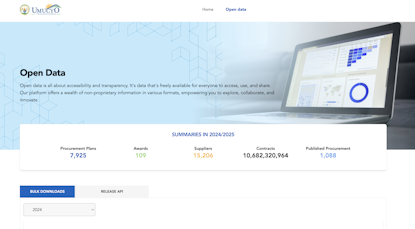Rwanda: A new open contracting portal to promote effective and inclusive procurement

Kigali is the center of Africa’s public procurement community this week. In time for this year’s Africa Public Procurement Network conference, hosted by Rwanda’s Public Procurement Authority (RPPA), the agency has developed a new open contracting portal that allows anyone to access data on government contracts dating back to 2016.
Supported by OCP, the platform is part of a larger data-driven reform that aims to improve the integrity of Rwanda’s procurement system while attracting more small- and women-led businesses to the procurement market and bolstering oversight of a notoriously high-risk sector.
Rwanda’s Umucyo system (meaning “transparency” in Kinyarwanda) is recognized as one of the most successful e-government procurement projects in Africa. Benchmarked on South Korea’s KONEPS, the system is used by all national and local government agencies to conduct almost all procurement procedures.
But despite the system’s wide adoption, unlocking Umucyo’s data for analysis has proved challenging, and affected the government’s ability to track the procurement system’s performance in areas such as efficiency, value for money and contract implementation. The lack of publicly available procurement information has also limited competition (as OCP’s recent regional research on barriers for women-led contractors shows), as well as contract monitoring by civil society.
Publishing standardized open data on public procurement
Launched publicly at the APPN General Assembly on 12 November, the new open contracting portal features machine-readable data published in the Open Contracting Data Standard (OCDS) format. This allows users to trace procedures across the planning, tender, award and contracting stages of the procurement cycle and to conduct system-wide analysis. The real-time data can be downloaded in common spreadsheet formats or accessed via API.
“By making procurement data machine-readable and accessible, the OCDS allows the tracking of key events, the comparison of contracts, and the identification of irregularities more effectively. Key data points or fields are essential for measuring key performance indicators and progress toward outcomes such as integrity, efficiency, competition, or value for money,” highlights Joyeuse Uwingeneye, the Director General of the RPPA.

Dozens of performance and corruption risk indicators can already be calculated using the current dataset. This will allow user-friendly data analytics and visualization tools to be developed in the next phase of the project, which will be based on the needs and priorities of different stakeholders.
Building coalitions and public oversight
Efforts are also being made to strengthen collaboration among procurement stakeholders including government procurement officers, auditors, entrepreneurs, engineers and other industry representatives, and transparency advocates. Convened by the recently revived Contracts Monitoring Coalition, government and civil society representatives are developing skills in using contracting documents and data to identify and fix procurement issues and inform policy decision-making.
Public oversight activities are being piloted in the districts of Rwamangana and Musanze through a cooperative agreement between Transparency International Rwanda and the local mayors, with support from OCP, that will see monitors track infrastructure projects worth RWF 12 billion (US$9.6 million).
TI-Rwanda has also established a call center that will facilitate complaints from bidders that can then be passed on to the competent authorities.
As Uwingeneye told us earlier this year, “you need to have visibility of what you are going to procure,” if you want to rethink procurement policies to build economic resilience, environmental sustainability, and inclusive growth. With the new open contracting, this visibility now extends to all stakeholders from government to businesses to civil society.